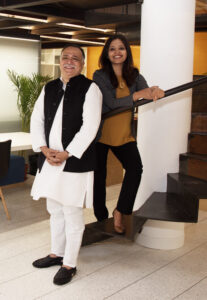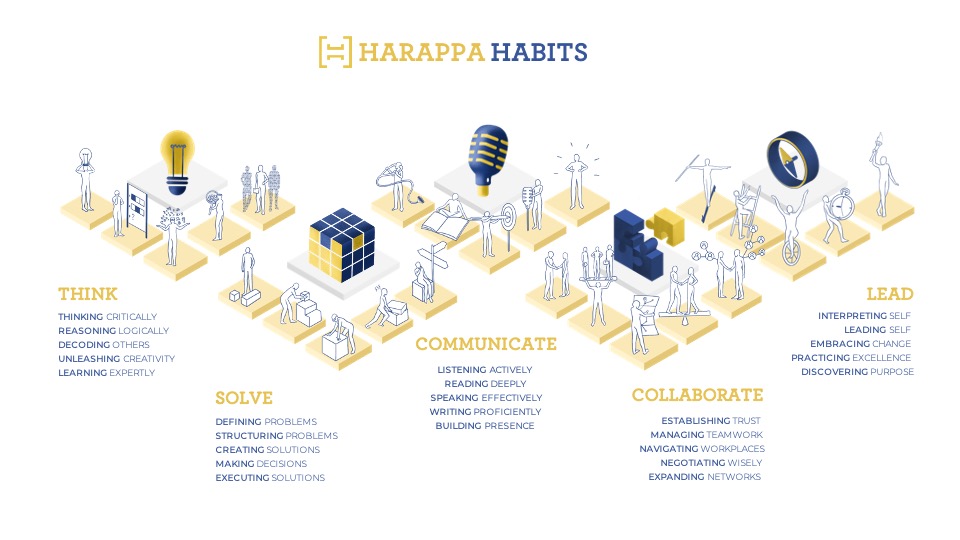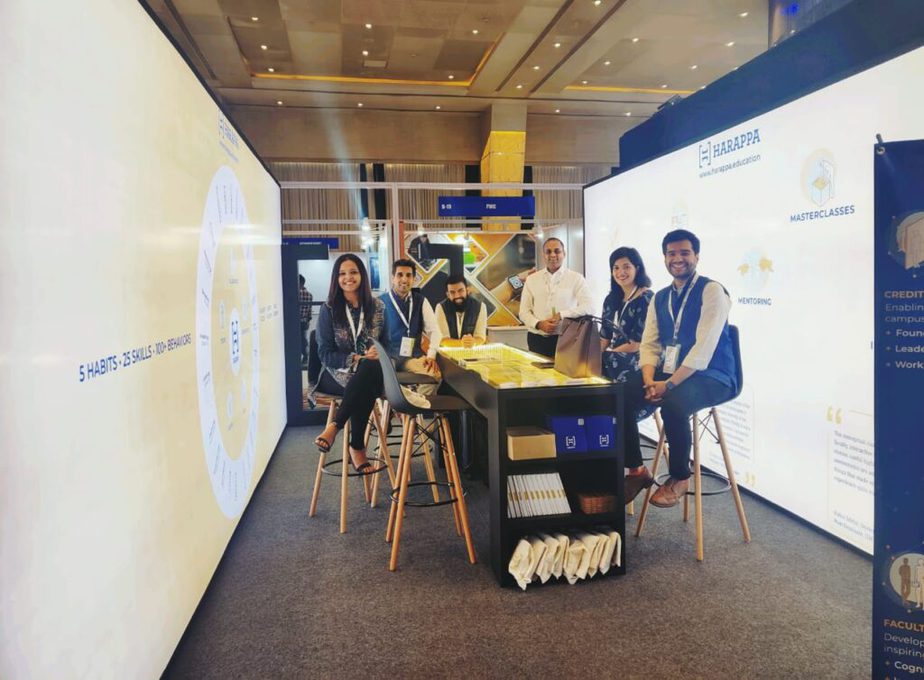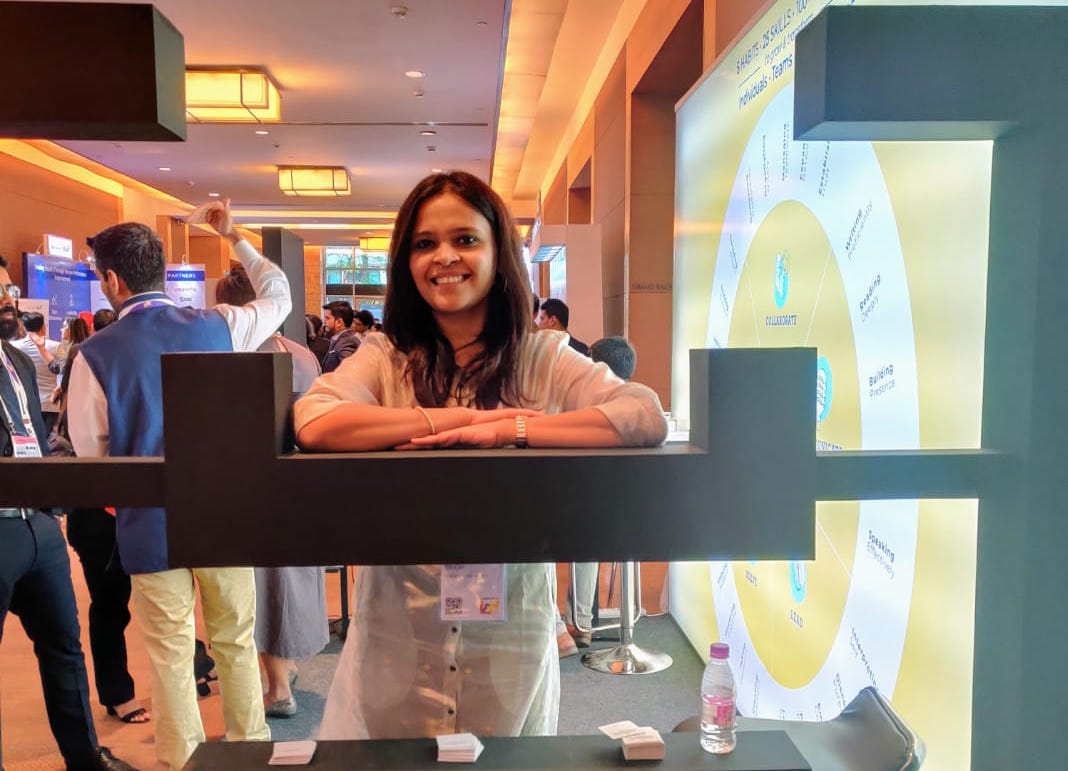Shreyasi Singh (SS) is the Founder and CEO of Harappa Education, an online learning institution dedicated to equipping adult learners with cognitive, social and behavioural skills key to their professional success and personal growth. Also co-founded by Pramath Raj Sinha, a pioneer in India’s education sector, the larger purpose of Harappa, as the team concisely notes, is to “begin where formal education ends.”

This “end” of formal education in India is marked by the higher education sector, which now includes a staggering 51,649 institutions. Yet, the sector finds itself crippled by a crisis of credibility, made worse by weak financing, and a generally low standard of education. Our universities remain fixated on textbook education, one that privileges knowledge recall over practical learning and professional skill development. It is in this largely neglected yet crucial space of formal professional development that Harappa, and thus Shreyasi’s work, locates itself.
As learners develop skills from top faculty in critical-thinking, problem-solving, leadership, communication, and collaboration using Harappa’s unique framework of ‘pracademics’, the potential of what ed-tech can do for India’s broken higher education system becomes clearer and clearer. In this week’s Dialogue, Shreyasi sits down with The Bastion’s Aarathi Ganesan (AG) to discuss Harappa’s journey and pedagogical process, as well as surviving the murky waters of entrepreneurship.
AG: What inspired you to start Harappa?
SS: Beginnings are never neat or easy and every time I tell these origin stories the messiness of what actually happened gets lost! That being said, there are three things that happened over six to eight months that led to the idea of Harappa and what we do.
Firstly, I was coming out of a professional experience where I had been introduced to higher education administration for the first time. That experience over two years was instrumental as it convinced me that higher education is an exciting place to make an impact. It is an honest, gratifying space of work, where you have the joy of seeing people transform in front of your eyes. It also showed me how great a business opportunity higher education is, given how broken and limited the larger system is in India.
Secondly, I used to be one of those people who said they’d never be an entrepreneur. Yet, when I spent those two years in higher education, I finally owned up to my own vision. I want to be recognised for the work that I do, and I don’t want my work to be lost. I wanted moral and emotional ownership over my work, which quite like writing an article, is a creator’s urge. So I think the nudge into entrepreneurship became clear for me from then. I wanted to build something from the ground-up, and that came from the sense of wanting to control my own destiny, as well as the growth, size, scale, and nature of what I was working on.

During this period, Pramath [Raj Sinha], the founder and chairman of Harappa, who I’ve worked with for over 10 years now and had actually been instrumental in my first shift into higher education, encouraged me to look at online learning. He’s spent 20 years in higher education and has done pioneering work in the sector. Yet, he’s aware of the impact of his footprint too. The combined intake of the institutions he’s helped build is only some 2,000 students a year. Some of them are extremely expensive options, again limiting access. He knew I was seeking out something I could own and shape and he simply asked, “Why don’t we come together to do this?” This confluence of interest in creating an impact in the education sector between us is the ‘second big thing’ that led to Harappa.
So, we now came to the idea that ‘online learning mein kuch karna hai, (we need to do something with online learning.)’ That was the aspiration we started with in August 2017 and explored over five months to really understand what the online space was, which was the third formative moment for Harappa. During this time we took three critical decisions. First, that we won’t simply become a distributor of existing educational services, products, or courses already being taught in colleges. In a country like ours, where courses are suffering from a crisis of curriculum, pedagogy, and quality, why would we want to peddle courses we don’t believe in? The second big decision was deciding that we don’t want to be in the technical or skills-based domain space, as there’s already high-quality, passionate work taking place in that sector anyway.
The third decision we took was zeroing down on a range of social, cognitive, and behavioural skills that we feel are crucial for professional success and personal growth for an individual. We realised that the current lack of such skills impacted teams and organisations. More importantly, this gap is simply not addressed at all by the formal higher education system in India.
We said we’ll broadly work for young professionals and young adults. So that’s the lens we were excited by and wanted to develop. On this basis, by March 2018, we had gradually created what people now see as the ‘Harappa Habits Framework’, which is essentially a set of 5 Habits and 25 Skills we nurture. I think after then, I’ve never had a moment of doubt that this isn’t an important vision to promote. So that is the sequential version of our messy 8-month journey when everything came together!
AG: Why the name Harappa though? How do you believe it captures the work you do?
SS: Naming the company Harappa was another critical moment for me. It’s such a strong emotional anchor, for the word itself connotes so much. We wanted to adopt the pioneering spirit that civilisation had, we wanted the timelessness of its wisdom that is still so evocative today. That sense of belief that we’re doing something important and worthwhile, which may be my life’s work (and a culmination of Pramath’s!), is really contained within a name like Harappa. There is great power in names, so you should choose them carefully.
AG: What are the challenges you see facing the ‘traditional’ model of higher education in India? How do you view online learning in light of them?
SS: Creating binaries between online and offline models is a reductive exercise. Why? Just look at the numbers. As a country, we, unfortunately, don’t have enough quality institutions to take on the challenge of educating and skilling all of our students. So it’s a challenge of numbers and access you have to deal with. In India, it’s not a realisable dream for all universities to cover all of that. You can’t just build $100 million dollar universities with 500 students each to fix the system. So we need to reconsider that elitist lens to ‘solving the education crisis’ as well. So, we need access to high-quality technical and skilling solutions, which online courses can offer. There’s no dichotomy there, rather, a symbiotic relationship between the online and offline instead.
The other challenge is that only a small percentage of our budget is allocated towards education, and of that, a fraction towards higher education. Even within such spending, how far does the money go to develop better curricula, pedagogies, learning outcomes, and learner motivation? Those are the evident issues facing higher education in India right now.
AG: So, once you’ve identified those gaps at Harappa, how do you go about developing pedagogies to help fill them?
SS: The challenges facing higher education in India are well-documented. What I find more exciting is to ask ‘how can we address these challenges?’ How you approach pedagogy development is critical here. There are five principles upon which we have built our pedagogy that help address the issues I mentioned.
The first is integrating the power of story-telling in the way we design our courses. As online educators, in the garb of education, you can’t afford to make your content boring. If we can be moved to tears by a Netflix show, what stops us from connecting that way with learning online? It’s all a question of delivery. The mission of making engaging, rich digital content, not unlike the way someone from the world of cinema would think about their craft, is something we take very seriously at Harappa.

The second principle is our focus on behavioural science and habit creation. We’re teaching adults; we don’t believe that knowledge recall and content comprehension alone are high-quality learning outcomes for them. Yet, those two outcomes are the pillars of a ‘good’ traditional education — the degree is now such a powerful document, that it masks low-quality learning outcomes. For us, true education must impact you enough for you to do something differently. We’re very application and behaviour change oriented — we want our learners to build habits out of the skills that we’re teaching them. Behavioural change is a critical unit of progress and learning at Harappa and lies at the core of our work.
The third principle is leveraging customised online learning, which is the real power of using digital technology. I’ve taught before myself, and there’s really no way you can tell who’s understanding what, or who’s even listening! At Harappa, each course is customised from user to user and using our technology, we can understand what an individual is learning, how they learn, their pace, their volume, and their curiosities.
The fourth principle is our interdisciplinary approach. Critical thinking is too wide a skill for one person to teach, no matter how experienced they are. So, we have seven professors working on a single course, such that no one course is the prerogative of a single professor. Bringing together different experts for a single course brings together multiple perspectives on how one concept can be applied in different contexts. This provides a variety of applied case studies while building greater exposure for Indian students and is again something that we’re very excited about.
The fifth and final principle is rich multimedia. We use video, audio, graphics, surveys and a plethora of other tools to bring together the knowledge on our platform. We get a lot of praise for our UI/UX. That hasn’t happened by accident. Harappa’s interface is a result of a conscious effort to make the on-screen recreation of the classroom rich and frictionless. It’s important to make the platform as high-quality as possible, especially given that we target young people who are hooked on to some of the best digital content from around the world. So that’s the fifth thing that we’re very committed to which sets us apart.
AG: How do you see technology bridging the social gap in access to education in India?
SS: Technology brings with it the power of accessibility, whether in terms of costs, location, or learning content. The power of autonomy that you give the learner, to decide what they’ll learn, how they’ll access knowledge, and in what time frame, is hugely liberating.

Technology also creates multiple pathways of learning for an adult. This ‘one-time’ concept of an education, where learning essentially stops at a bachelor’s or master’s degree, is ill-equipped to help us deal with the varied kind of careers we all have. Life, the workplace — these are all our campuses too! There aren’t enough opportunities for adults where they can dip in and out of learning programs as and when they need to. For example, in three years your current job could require you to pick up a completely different skill set. You simply can’t go back to college and do a master’s for every skill you want to pick up, and you don’t need to. Some skills don’t require that level of depth or style of learning.
We need to engineer opportunities that cater to constant development even after higher education, which is something we offer at Harappa. So, technology also enables choice, which is a powerful thing to enhance in any education system that struggles with equity.
AG: What’s the dream for Harappa? Where do you see the platform 10 years down the line?
SS: 10 years is a bit too far down the line — let’s aim for five instead! We have two five year goals. We certainly want to be the leading institution for developing cognitive-social–behavioural skills, providing quality education equivalent to what you receive at premier institutions operating in the same space. That is our “flagship program”, so to speak. Second, we want to be India’s largest online learning institution by way of numbers: upwards of 5,00,000 learners is what we’re looking to impactfully scale up to. If we succeed at those two big goals, our mission will be successful.
AG: They certainly are big goals! As our CEO Sourya says, always dream high. He’s full of inspirational quotes, especially when I’m gloomy about numbers.
SS: Oh, I agree with him completely. When you’re an entrepreneur, you need to set your sights very high. Whether through a vision or a quantitative metric, that goal needs to be there. Otherwise, you’ll get lost. Your aspirations need to be your anchor when you’re building something, because that process will be chaotic and ridden with events you can’t anticipate! To make it through, you need to recall the power of the vision you started with, and the power of the vision you’re aspiring to.
Featured image courtesy of Shreyasi Singh. | Views expressed are personal.







Excellent article and well done Shreyasi. As an online educator (Mashauri.org) I particularly like the 5 principles used in your pedagogy – that is certainly optimising the benefits of online education.